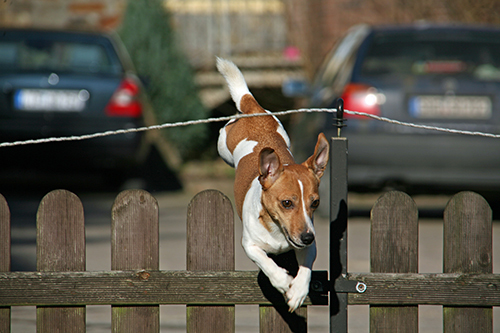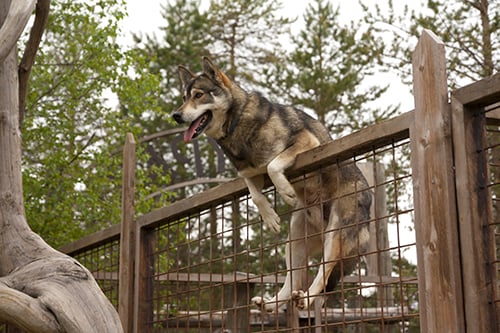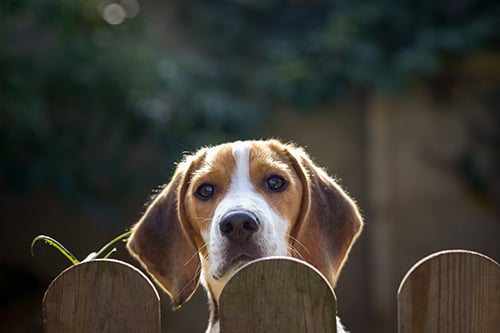How to Choose the Ideal Fence for Your Dog
4 Things to Consider When Selecting Fencing for Your Dog
Few things make dogs happier than the ability to freely roam their own yard. There are squirrels to be chased, flowers to pee on, cars to bark at, and above all else, fortresses to be protected! Unfortunately, the positives of having a dog-friendly yard can quickly turn to negatives if your dog escapes your property. Having your dog running freely throughout your neighborhood not only poses a safety concern for your pet, but—depending on its breed and character—for your neighbors as well.
If you plan to give your dog full reign of your yard, it would be wise to put some containment measures in place. For safe confinement of your four-legged friend, installing a physical fence around your yard is aesthetically and practically speaking, your best option. There are tons of different fence types on the market, but you need to put some thought into the ones that are well suited for dog-occupied yards—and your specific circumstances will determine which type of fence will work best for your intended application.
To help you narrow down your fencing choices, we’ve developed a list of important variables to consider before buying a fence for your dog. Read along below:
1. The Breed of Your Dog and Their Escape Methods
The first thing you must consider before installing a dog-appropriate fence in your yard is the breed of your dog. Being knowledgeable about your dog’s breed, observing its individual behaviors, and accounting for your pet’s size, intelligence level, and athletic ability are all crucial factors in determining an effective fencing solution.
This is a given, as no two dogs are created equal. A four-foot wooden fence may be fine for keeping your pug at bay, but it certainly won’t stop an athletic husky from jumping over and escaping. Furthermore, a chain-link fence may look on paper to be an affordable and sensible solution, until your pit bull takes the initiative to climb right over it. If you dog’s really smart, it may even circumvent the techniques mentioned above and simply unlatch your fence’s gate when you’re not looking. The point being that different dogs employ different escape strategies, which means there really isn’t a one-size-fits-all solution to dog fencing.
Although we probably couldn’t list all the different types of “Houndini” acts dogs have used to escape yards in the past, most use one of the 5 following methods:

- Jumping over the fence.
- Climbing over the fence.
- Digging under the fence.
- Chewing through or knocking down the fence.
- Using the nose or paw to lift the gate latch.
To find an appropriate fence, you’ll need to assess which of the following techniques your dog is most likely to use and address them with a suitable design.
2. Fence Height: Addressing the Jumpers
To address jumping concerns, you’ll need to estimate a proper height for your fence. Any type of fence with a height of four feet or less is unlikely to deter the larger dog breeds, but may be enough to contain the little guys. However, if you want to be on the safe side, a five-to six-foot-tall fence should be sufficient for most breeds.
It’s important to note here that if you currently have a fence that’s inadequate in height, it’s better to rip it out and install a new one rather than trying to extend the top of it. When you add an extension to your fence, you weaken its structure. Even though your fence’s extension may be tall enough for your dog not to clear, they may still try and could dislodge the extension in the process—leading to an escape and/or possible injuries to your pet.
3. Fence Material: Addressing the Climbers, Chewers, and Brutes
Choosing an appropriate fencing material is another extremely important factor to consider. If your dog has the athletic ability to climb over a fence, then unfortunately, you should take chain-link materials right off your list of considerations—they provide your dog easy footholds to step up on. For climbers, you’ll want to install something with a smooth surface that won’t provide them any traction or footholds to work off of. For breeds with impressive climbing capabilities, we highly recommend our vinyl or cedar fences to keep them on the ground and safely within your property line.
A dog with a strong jaw—or body—is completely capable of chewing or busting through a fence that’s not structurally sound. Generally speaking, wooden materials aren’t best to address this concern, as many dogs love to chew wood and can harm themselves with splinters during the process. If you think you have a chewer or a brute on your hands, then check out these durable chain-link and aluminum fencing options.

4. Fence Design and Gate: Addressing the Diggers and “Houndini Artists”
To curb concerns regarding your dog digging under your fence, you’re going to have to get a little creative with the design. One option is installing a gravel barrier at the base of the fence, which may discourage your dog from digging under it. For a more heavy-duty solution, we recommend installing a fence that extends below ground level about one to two feet. Keep in mind, this will require you to dig a trench and will also increase your material cost; but when it comes to pets, being safe is better than being sorry.
You’d be surprised how many stories we hear of dogs unlatching gates in human-like manners. Of course, if you’re a dog lover, we aren’t telling you anything new about how surprisingly crafty some of these pups can be! If you have a little smarty-pants under your roof, you need to be careful when considering your fence’s gate design. Many gate latches are far too easily nudged open by a curious nose, so it’s important to either place this latch out of reach or make it too complicated to solve without apposable thumbs.
The best way to thwart the efforts of the gate openers is to add a basic padlock or dog-proof clip to the gate—this will prevent most dogs from freeing themselves. If you have concerns over gate design, then check out our various fence gate options here, or contact us to discuss a custom solution that will meet your specific needs.
Finally, you may ask, “What about invisible fences?” Electric fences seem like an easy solution to keep the pets in the yards; however, they can worsen behavior problems in some cases, as not all dogs can associate the discomfort of shocks with approaching a boundary line. Before investing in an invisible fence in place of a physical fence for your dog, check out this article that discusses the effectiveness of invisible fences.
How AVO Can Help
If you need help choosing a fence to meet your specifications and budget, contact us now for a free consultation. We are happy to help homeowners find the fencing solutions you need to make your property secure, safe, and aesthetic at affordable prices. And of course, your pups as happy as they can be while roaming the roost.

